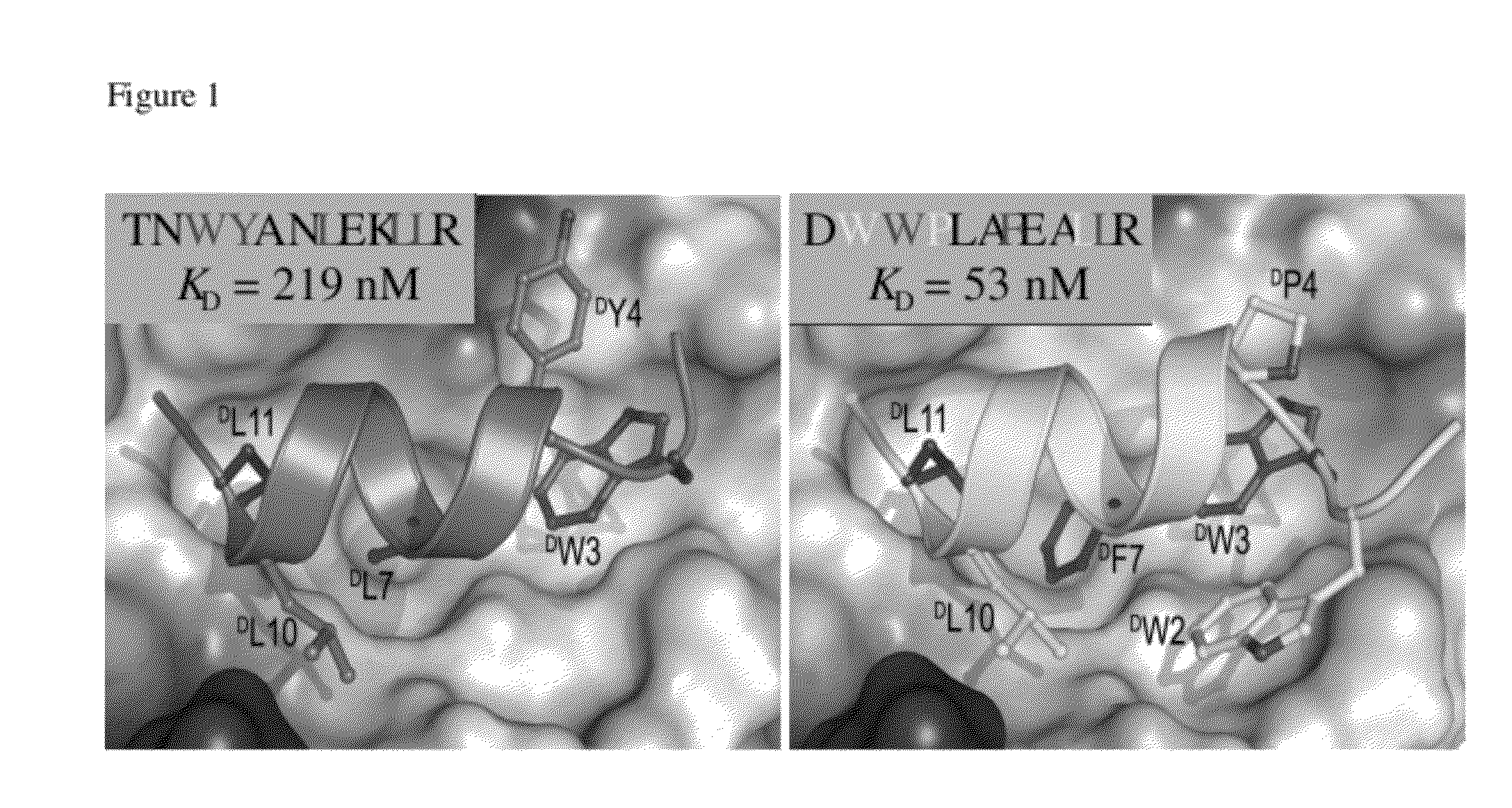Potent d-peptide antagonists of mdm2 and mdmx for anticancer therapy
a d-peptide antagonist and anticancer technology, applied in the direction of peptides, drug compositions, peptides/protein ingredients, etc., can solve the problems of limiting the therapeutic value, peptides generally exhibit excessive backbone flexibility, and poor membrane permeability, so as to promote the expression of polynucleotides
- Summary
- Abstract
- Description
- Claims
- Application Information
AI Technical Summary
Benefits of technology
Problems solved by technology
Method used
Image
Examples
example 1
Identification of Potent D-Peptide Inhibitors of the p53-MDM2 Interaction by Mirror Image Phage Display
[0088]Previously, a potent dual-specificity L-peptide inhibitor of the p53-MDM2 / MDMX interactions was identified via phage display and structurally characterized (Pazgier M, et al. Proc Natl Acad Sci USA 106(12):4665-70 (2009)). The duodecimal peptide, termed PMI (TSFAEYWNLLSP; SEQ ID NO:63), bound the p53-binding domains of MDM2 (25-109MDM2 or synMDM2) and MDMX (24-108MDMX or syn MDMX) at affinities of 3.2 and 8.5 nM, respectively, as determined by surface plasmon resonance (SPR) and isothermal titration calorimetry (ITC) techniques (Pazgier M, et al. Proc Natl Acad Sci USA 106(12):4665-70 (2009); Li C, et al. Angew Chem Int Ed Engl 48(46):8712-5 (2009); Li C, et al. J Mol Biol 398(2):200-13 (2010)). A single mutation, N8A, turned PMI into one of the most potent dual-specificity inhibitors of the p53-MDM2 / MDMX interactions reported to date, registering respective KD values of 490 ...
example 2
In Vitro and In Vivo Studies of D-Peptide Inhibitors
[0090]Each of the D-peptides is fully resistant to proteolysis (Liu M, et al. Proc Natl Acad Sci USA 107(32):14321-6 (2010); Liu M, et al. Angew Chem Int Ed Engl 49(21):3649-3652 (2010)). To increase cell-membrane permeability of the D-peptides, PEGylated liposomes were designed as a carrier vehicles to encapsulate the D-peptides. The encapsulated D-peptides were evaluated for their anti-tumor activity in vitro and therapeutic efficacy in vivo. As integrin avβ3 is highly expressed on the surface of glioma tumor cells (Desgrosellier J S and Cheresh D A. Nat Rev Cancer 10(1):9-22 (2010); Gladson C L and Cheresh D A. J Clin Invest 88(6):1924-32 (1991)), the tumor model for this study, therefore liposomes were also coated via a PEG spacer with a cyclic RGD peptide c(RGDDYK) to facilitate tumor-specific targeting. As shown in FIG. 2, DPMI-α induced a dose-dependent growth inhibition of human glioma cell line U87 (wild type p53) with an ...
example 3
Functional Optimization of DPMI-β
[0092]Structural analysis of MDM2 complexed with DPMI-β and DPMI-γ indicates that an unfilled space would exist in the binding pocket of Phe7 of DPMI-β despite the fact DPMI-β is the strongest ligand of MDM2 among the three. In the absence of a crystal structure of DPMI-β-MDM2, Phe7 was modified with 4-X-Phe and it was found that 4-X-Phe7-DPMI-β binding to MDM2 improved when X=F, Cl, Br, I, CH3, CF3 or CN and weakened when X=OH or NO2. Remarkably, substitution of 4-CF3-Phe for Phe7 dramatically enhanced the binding affinity of DPMI-β for MDM2 by ˜80-fold as measured by competition SPR (FIG. 3), consistent with the change of IC50 values determined in a fluorescence polarization (FP)-based competition assay. The crystal structure of 4-CF3-Phe7-DPMI-β in complex with MDM2 was determined at 1.75 Å resolution (FIG. 3). MDM2-bound 4-CF3-Phe7-DPMI-β and DPMI-α are nearly identical, structurally validating the experimental design. Notably, a modest 2-fold im...
PUM
| Property | Measurement | Unit |
|---|---|---|
| Composition | aaaaa | aaaaa |
| Affinity | aaaaa | aaaaa |
Abstract
Description
Claims
Application Information
 Login to View More
Login to View More - R&D
- Intellectual Property
- Life Sciences
- Materials
- Tech Scout
- Unparalleled Data Quality
- Higher Quality Content
- 60% Fewer Hallucinations
Browse by: Latest US Patents, China's latest patents, Technical Efficacy Thesaurus, Application Domain, Technology Topic, Popular Technical Reports.
© 2025 PatSnap. All rights reserved.Legal|Privacy policy|Modern Slavery Act Transparency Statement|Sitemap|About US| Contact US: help@patsnap.com



